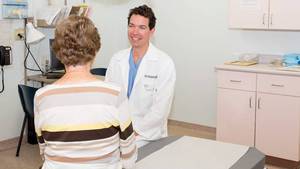The QEII’s Rehabilitation Centre is filled with people who’ve had their lives changed by an accident, illness or condition beyond their control. And since 1977 this centre’s equipment and staff have assisted patients in their uphill battles to take back what they’ve lost.
“Rehab is hard work,” says Randi Monroe, director of the QEII’s Rehabilitation and Supportive Care Services. For some patients, rehabilitation means adjusting to the loss of a limb, recovering from a traumatic brain injury, or overcoming neurological or musculoskeletal conditions. Many have suffered strokes, she says, losing their mobility, coordination, strength, and even speech in some cases.
“Strokes are the most common cause of disability in the adult population,” adds Dr. Christine Short, QEII division chief of physical medicine and rehabilitation.
Charles Nauss is one of those adults. Just over three years ago, the outdoorsy resident of Beaver Bank suddenly traded his golf clubs for a wheelchair. His stroke left one side of his body paralyzed.
“People don’t always think about taking care of their health,” says Charles, “but you have to, because when it’s gone, it’s gone for good.”
For over three decades, one of this facility’s most powerful tools for rehabilitation sat quietly on its third floor, the unsung hero for so many grateful patients. This hero was a therapeutic pool, designed like an enormous staircase, with different levels leading progressively into deeper waters.
“Depending on how much water we put somebody in, we can reduce a certain amount of their body weight,” Dr. Short explains. This was important for patients unable to carry their full weight, but who needed to exercise their limbs for recovery. The water was kept at 35 °C to soothe stiff muscles and ease unwelcome pain. This “healing haven,” in Randi’s words, got patients on their feet more quickly to retrain and restore their damaged bodies, and in the rehabilitation business, time is of the essence.
“A therapeutic pool was one of the cornerstones of this building,” says Randi. But time took its toll on the structure. After a series of broken pipes and floods disrupted patient care and daily operations, the pool was closed in December 2011, before Charles could enjoy his first dip.
“Our staff, former patients and current patients all took it very hard,” says Randi. “But it’s something we had to do for everyone’s safety.”
The loss was felt immediately. Patients in the centre’s neurological rehabilitation and musculoskeletal units - who used the pool most often - began taking longer to recover. For many staff, one of their most effective treatments was no longer at their fingertips. The centre invested in other equipment to fill the void, but nothing quite measured up.
In November 2013, the QEII Foundation’s $2.6-million
With the campaign completed, the new therapeutic pool will open this summer with noticeable improvements beyond the structure of the pool. The ceiling lights will be diffused to have the softening affect of a cloud; the wall panels will have varying, lively colours; and the change rooms will be built to maximize independence. Experts in the field of hydrotherapy have been consulted to support staff in providing the best care possible for patients.
With a gift of $1-million, the Hansen MacDonald family of Colin and Carol, along with sons Nicholas and Luke, wanted to honour Carol’s mother. On June 16, The Grace Hansen Therapeutic Pool was officially dedicated at a gathering of current and former staff and patients, and the many donors who made this dream a reality.
The QEII’s Rehabilitation Centre has changed innumerable lives for the better, restoring quality of life and in many cases, getting patients back on their feet. Although his golf swing is now somewhat unorthodox, Charles was able to return to his beloved pastime, thanks to his healthcare team.
“The Rehabilitation Centre is a wonderful place,” says Charles. “I think many people have come to appreciate what they do for patients like me.”








